专题2 名词详解练习题
- 格式:doc
- 大小:64.00 KB
- 文档页数:13
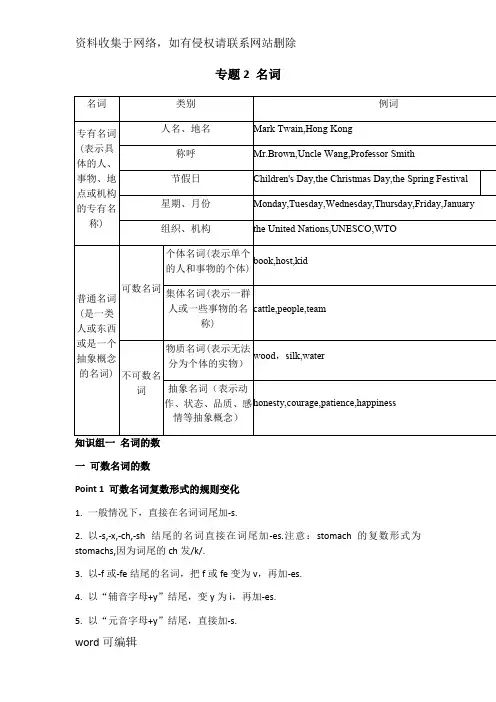
专题2 名词知识组一名词的数一可数名词的数Point 1 可数名词复数形式的规则变化1.一般情况下,直接在名词词尾加-s.2.以-s,-x,-ch,-sh结尾的名词直接在词尾加-es.注意:stomach的复数形式为stomachs,因为词尾的ch发/k/.3.以-f或-fe结尾的名词,把f或fe变为v,再加-es.4.以“辅音字母+y”结尾,变y为i,再加-es.5.以“元音字母+y”结尾,直接加-s.6.以“辅音字母+o”结尾,多数情况下加-es.7.以“辅音字母+o”结尾,一般加-s.Point 2 可数名词复数形式的不规则变化8.改变单词内的元音字母:如foot-feet,tooth-teeth,mouse-mice,man-men,policewoman-policemen9.词尾加-en或-ren.ox-oxen,child-children10.有些名词单复数同形。
如,sheep,deer,means,series,works11.表示某国人的名词,有三种情况:(a)单复数相同;如Japanese,Chinese,Swiss (b)变-man为-men;Frenchman-Frenchmen,Englishman-Englishmen(c)词尾加-s,German-Germans,Russian-Russians,American-Americans.请按照单数名词变复数规则,变换下列单数名词。
desk________________ glass________________box________________ brush________________leaf________________ thief________________wife________________ wolf________________factory________________ goose________________monkey________________ mouse________________month________________ foot________________bath________________ hero________________brush________________ German________________dog________________ Negro________________friend________________ photo________________map________________ Chinese________________watch________________ Swiss________________Point 3 复合名词的复数形式:1.一般将主体名词变为复数。
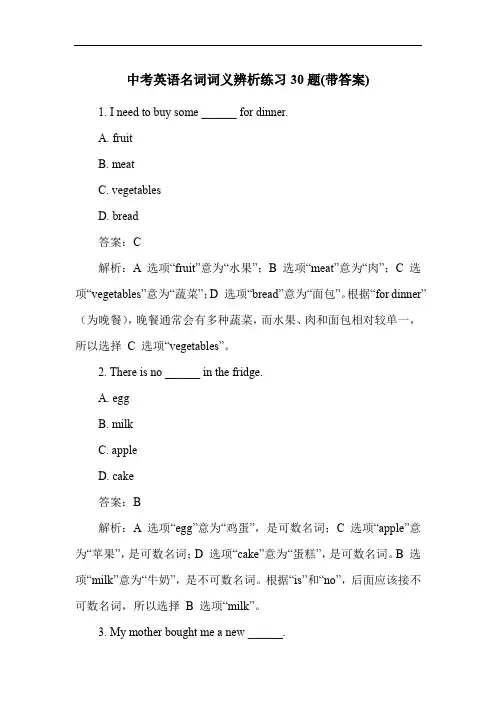
中考英语名词词义辨析练习30题(带答案)1. I need to buy some ______ for dinner.A. fruitB. meatC. vegetablesD. bread答案:C解析:A 选项“fruit”意为“水果”;B 选项“meat”意为“肉”;C 选项“vegetables”意为“蔬菜”;D 选项“bread”意为“面包”。
根据“for dinner”(为晚餐),晚餐通常会有多种蔬菜,而水果、肉和面包相对较单一,所以选择C 选项“vegetables”。
2. There is no ______ in the fridge.A. eggB. milkC. appleD. cake答案:B解析:A 选项“egg”意为“鸡蛋”,是可数名词;C 选项“apple”意为“苹果”,是可数名词;D 选项“cake”意为“蛋糕”,是可数名词。
B 选项“milk”意为“牛奶”,是不可数名词。
根据“is”和“no”,后面应该接不可数名词,所以选择B 选项“milk”。
3. My mother bought me a new ______.B. shirtC. coatD. skirt答案:A解析:A 选项“dress”意为“连衣裙”;B 选项“shirt”意为“衬衫”;C 选项“coat”意为“外套”;D 选项“skirt”意为“裙子”。
“a new”后面接可数名词单数,连衣裙更能体现是新买的一件完整的衣服,其他选项相对较局限,所以选择 A 选项“dress”。
4. We need some ______ to make a cake.A. flourB. sugarC. eggsD. butter答案:C解析:A 选项“flour”意为“面粉”;B 选项“sugar”意为“糖”;C 选项“eggs”意为“鸡蛋”;D 选项“butter”意为“黄油”。
做蛋糕通常需要鸡蛋,其他选项虽然也是做蛋糕的材料,但鸡蛋是必不可少的,所以选择C 选项“eggs”。
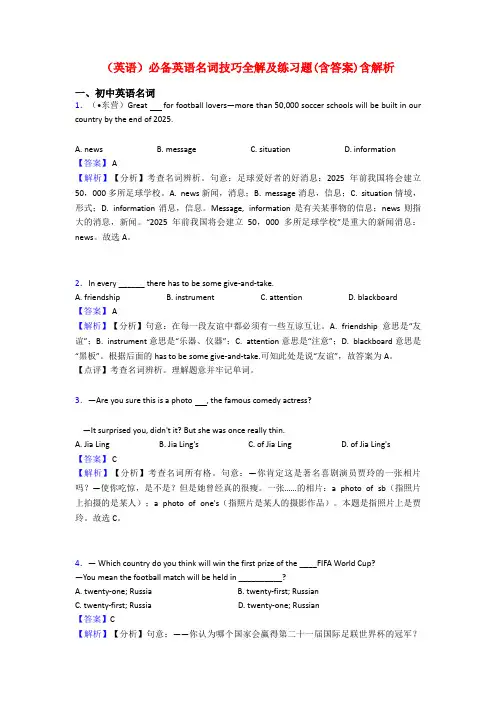
(英语)必备英语名词技巧全解及练习题(含答案)含解析一、初中英语名词1.(•东营)Great for football lovers—more than 50,000 soccer schools will be built in our country by the end of 2025.A. newsB. messageC. situationD. information【答案】 A【解析】【分析】考查名词辨析。
句意:足球爱好者的好消息:2025年前我国将会建立50,000多所足球学校。
A. news新闻,消息;B. message消息,信息;C. situation情境,形式;D. information消息,信息。
Message, information是有关某事物的信息;news则指大的消息,新闻。
“2025年前我国将会建立50,000多所足球学校”是重大的新闻消息:news。
故选A。
2.In every ______ there has to be some give-and-take.A. friendshipB. instrumentC. attentionD. blackboard【答案】 A【解析】【分析】句意:在每一段友谊中都必须有一些互谅互让。
A. friendship意思是“友谊”;B. instrument意思是“乐器、仪器”;C. attention意思是“注意”;D. blackboard意思是“黑板”。
根据后面的has to be some give-and-take.可知此处是说“友谊”,故答案为A。
【点评】考查名词辨析。
理解题意并牢记单词。
3.—Are you sure this is a photo , the famous comedy actress?—It surprised you, didn't it? But she was once really thin.A. Jia LingB. Jia Ling'sC. of Jia LingD. of Jia Ling's【答案】 C【解析】【分析】考查名词所有格。
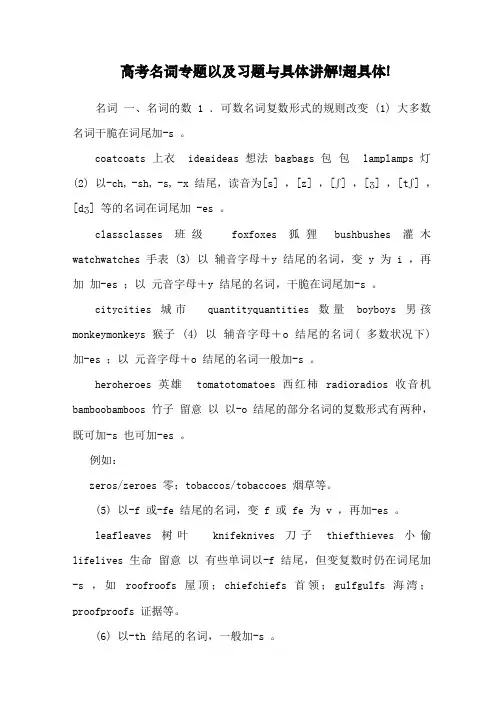
高考名词专题以及习题与具体讲解!超具体!名词一、名词的数 1 .可数名词复数形式的规则改变 (1) 大多数名词干脆在词尾加-s 。
coatcoats 上衣 ideaideas 想法 bagbags 包包 lamplamps 灯(2) 以-ch, -sh, -s, -x 结尾,读音为[s] ,[z] ,[ʃ] ,[ʒ] ,[tʃ] ,[dʒ] 等的名词在词尾加 -es 。
classclasses 班级foxfoxes 狐狸bushbushes 灌木watchwatches 手表 (3) 以辅音字母+y 结尾的名词,变 y 为 i ,再加加-es ;以元音字母+y 结尾的名词,干脆在词尾加-s 。
citycities 城市quantityquantities 数量boyboys 男孩monkeymonkeys 猴子 (4) 以辅音字母+o 结尾的名词( 多数状况下) 加-es ;以元音字母+o 结尾的名词一般加-s 。
heroheroes 英雄 tomatotomatoes 西红柿 radioradios 收音机bamboobamboos 竹子留意以以-o 结尾的部分名词的复数形式有两种,既可加-s 也可加-es 。
例如:zeros/zeroes 零;tobaccos/tobaccoes 烟草等。
(5) 以-f 或-fe 结尾的名词,变 f 或 fe 为 v ,再加-es 。
leafleaves 树叶knifeknives 刀子thiefthieves 小偷lifelives 生命留意以有些单词以-f 结尾,但变复数时仍在词尾加-s ,如roofroofs 屋顶;chiefchiefs 首领;gulfgulfs 海湾;proofproofs 证据等。
(6) 以-th 结尾的名词,一般加-s 。
mouthmouths 嘴嘴 pathpaths 小路 2 .可数名词复数形式的不规则改变 (1) 常见名词的不规则复数形式 manmen 男子 toothteeth 牙齿 mousemice 老鼠 goosegeese 鹅 childchildren 儿童 oxoxen 公牛 (2) 单复数同形的名词 sheep 绵羊 deer 鹿鹿 Chinese 中国人 fish 鱼 means 方式;方法 3 .复合名词的复数复合名词变复数时,将其中主要的词变成复数。
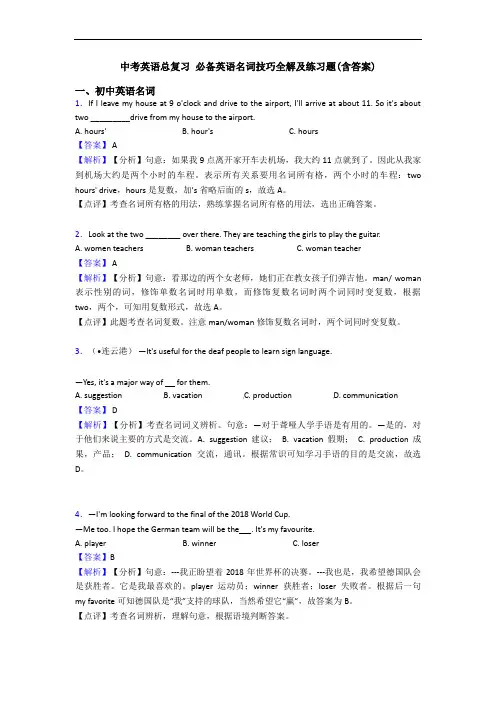
中考英语总复习必备英语名词技巧全解及练习题(含答案)一、初中英语名词1.If I leave my house at 9 o'clock and drive to the airport, I'll arrive at about 11. So it's about two _________drive from my house to the airport.A. hours'B. hour'sC. hours【答案】 A【解析】【分析】句意:如果我9点离开家开车去机场,我大约11点就到了。
因此从我家到机场大约是两个小时的车程。
表示所有关系要用名词所有格,两个小时的车程:two hours' drive,hours是复数,加's省略后面的s,故选A。
【点评】考查名词所有格的用法,熟练掌握名词所有格的用法,选出正确答案。
2.Look at the two ________ over there. They are teaching the girls to play the guitar.A. women teachersB. woman teachersC. woman teacher【答案】 A【解析】【分析】句意:看那边的两个女老师,她们正在教女孩子们弹吉他。
man/ woman 表示性别的词,修饰单数名词时用单数,而修饰复数名词时两个词同时变复数,根据two,两个,可知用复数形式,故选A。
【点评】此题考查名词复数。
注意man/woman修饰复数名词时,两个词同时变复数。
3.(•连云港)—It's useful for the deaf people to learn sign language.—Yes, it's a major way of for them.A. suggestionB. vacationC. productionD. communication【答案】 D【解析】【分析】考查名词词义辨析。
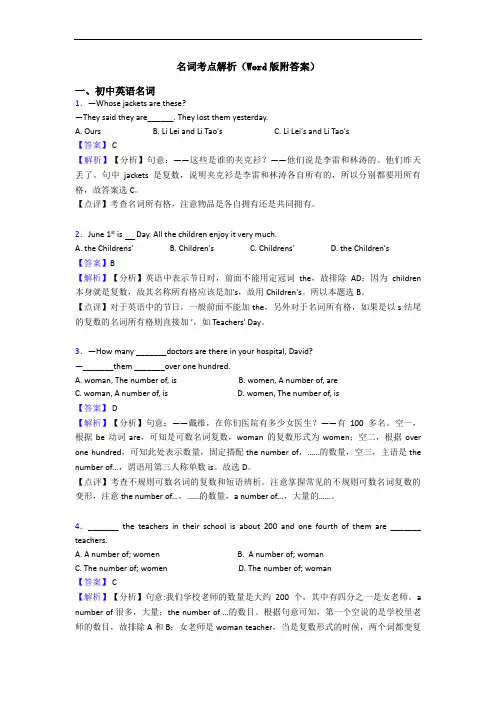
名词考点解析(Word版附答案)一、初中英语名词1.—Whose jackets are these?—They said they are______. They lost them yesterday.A. OursB. Li Lei and Li Tao'sC. Li Lei′s and Li Tao's【答案】 C【解析】【分析】句意:——这些是谁的夹克衫?——他们说是李雷和林涛的。
他们昨天丢了。
句中jackets是复数,说明夹克衫是李雷和林涛各自所有的,所以分别都要用所有格,故答案选C。
【点评】考查名词所有格,注意物品是各自拥有还是共同拥有。
2.June 1st is Day. All the children enjoy it very much.A. the Childrens’B. Children'sC. Childrens’D. the Children's【答案】B【解析】【分析】英语中表示节日时,前面不能用定冠词the,故排除AD;因为children 本身就是复数,故其名称所有格应该是加's,故用Children's。
所以本题选B。
【点评】对于英语中的节日,一般前面不能加the,另外对于名词所有格,如果是以s结尾的复数的名词所有格则直接加’,如Teachers' Day。
3.—How many _______doctors are there in your hospital, David?—_______them _______over one hundred.A. woman, The number of, isB. women, A number of, areC. woman, A number of, isD. women, The number of, is【答案】 D【解析】【分析】句意:——戴维,在你们医院有多少女医生?——有100多名。
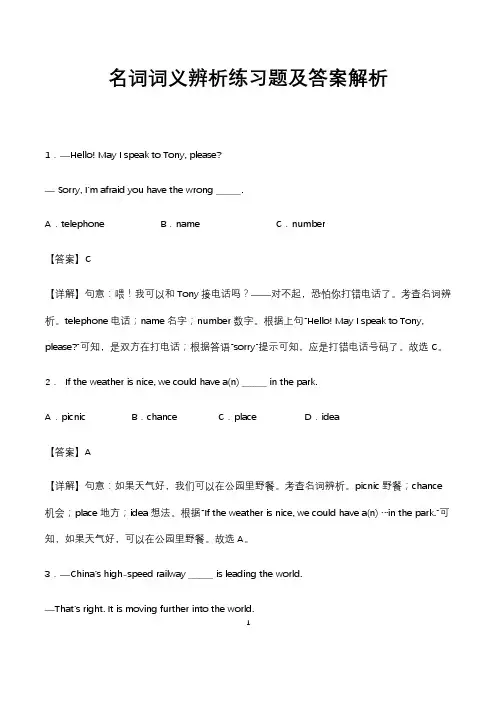
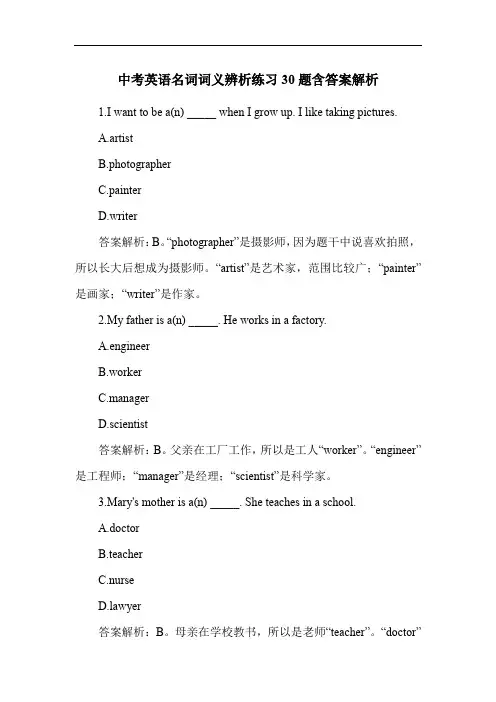
中考英语名词词义辨析练习30题含答案解析1.I want to be a(n) _____ when I grow up. I like taking pictures.A.artistB.photographerC.painterD.writer答案解析:B。
“photographer”是摄影师,因为题干中说喜欢拍照,所以长大后想成为摄影师。
“artist”是艺术家,范围比较广;“painter”是画家;“writer”是作家。
2.My father is a(n) _____. He works in a factory.A.engineerB.workerC.managerD.scientist答案解析:B。
父亲在工厂工作,所以是工人“worker”。
“engineer”是工程师;“manager”是经理;“scientist”是科学家。
3.Mary's mother is a(n) _____. She teaches in a school.A.doctorB.teacherC.nursewyer答案解析:B。
母亲在学校教书,所以是老师“teacher”。
“doctor”是医生;“nurse”是护士;“lawyer”是律师。
4.Tom wants to be a(n) _____ in the future. He is good at playing basketball.A.athleteB.singerC.actorD.dancer答案解析:A。
汤姆擅长打篮球,所以未来想成为运动员“athlete”。
“singer”是歌手;“actor”是演员;“dancer”是舞者。
5.My aunt is a(n) _____. She helps sick people.A.policemanB.firefighterC.doctorD.postman答案解析:C。
阿姨帮助病人,所以是医生“doctor”。
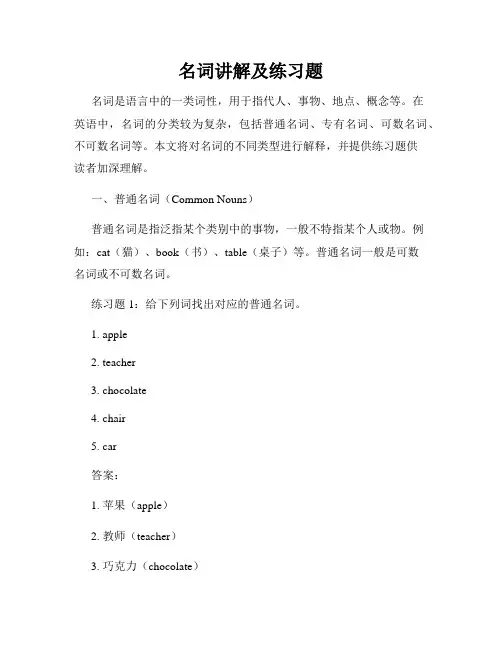
名词讲解及练习题名词是语言中的一类词性,用于指代人、事物、地点、概念等。
在英语中,名词的分类较为复杂,包括普通名词、专有名词、可数名词、不可数名词等。
本文将对名词的不同类型进行解释,并提供练习题供读者加深理解。
一、普通名词(Common Nouns)普通名词是指泛指某个类别中的事物,一般不特指某个人或物。
例如:cat(猫)、book(书)、table(桌子)等。
普通名词一般是可数名词或不可数名词。
练习题 1:给下列词找出对应的普通名词。
1. apple2. teacher3. chocolate4. chair5. car答案:1. 苹果(apple)2. 教师(teacher)3. 巧克力(chocolate)4. 椅子(chair)5. 车(car)二、专有名词(Proper Nouns)专有名词是指特指某个人、地点、组织或品牌等的名词。
专有名词通常首字母大写。
例如:John(约翰)、London(伦敦)、Microsoft (微软)等。
练习题 2:给下列词找出对应的专有名词。
1. boy2. paris3. iphone4. doctor5. nike答案:1. 男孩(boy)2. 巴黎(Paris)3. 苹果手机(iPhone)4. 医生(doctor)5. 耐克(Nike)三、可数名词(Countable Nouns)可数名词是指可以用数目进行计算的名词,可以有单数和复数形式。
例如:book(书)可以是单数形式,books(书)则是复数形式。
练习题 3:把下列单数形式的名词转化为复数形式。
1. pen2. child3. cup4. book5. dog答案:1. pens2. children3. cups4. books5. dogs四、不可数名词(Uncountable Nouns)不可数名词是指无法进行数目计算的名词,通常表示抽象概念、物质或集合。
不可数名词没有复数形式。
例如:water(水)、money (钱)、information(信息)等。
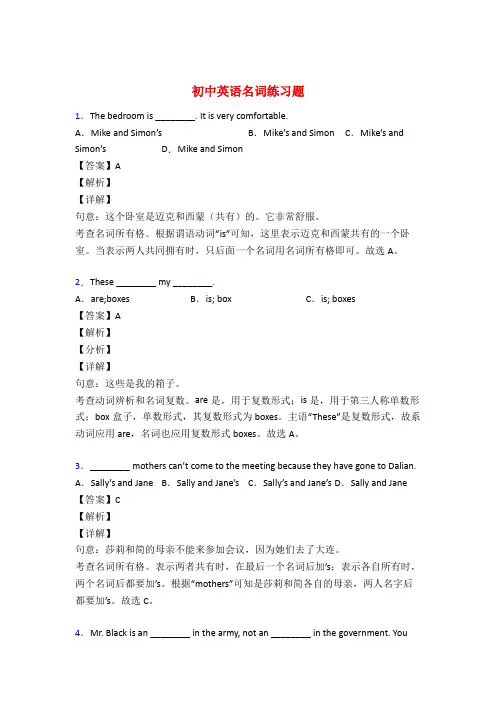
初中英语名词练习题1.The bedroom is ________. It is very comfortable.A.Mike and Simon’s B.Mike’s and Simon C.Mike’s and Simon’s D.Mike and Simon【答案】A【解析】【详解】句意:这个卧室是迈克和西蒙(共有)的。
它非常舒服。
考查名词所有格。
根据谓语动词“is”可知,这里表示迈克和西蒙共有的一个卧室。
当表示两人共同拥有时,只后面一个名词用名词所有格即可。
故选A。
2.These ________ my ________.A.are;boxes B.is; box C.is; boxes【答案】A【解析】【分析】【详解】句意:这些是我的箱子。
考查动词辨析和名词复数。
are是,用于复数形式;is是,用于第三人称单数形式;box盒子,单数形式,其复数形式为boxes。
主语“These”是复数形式,故系动词应用are,名词也应用复数形式boxes。
故选A。
3.________ mothers can’t come to the meeting because th ey have gone to Dalian. A.Sally’s and Jane B.Sally and Jane’s C.Sally’s and Jane’s D.Sally and Jane 【答案】C【解析】【详解】句意:莎莉和简的母亲不能来参加会议,因为她们去了大连。
考查名词所有格。
表示两者共有时,在最后一个名词后加’s;表示各自所有时,两个名词后都要加’s。
根据“mothers”可知是莎莉和简各自的母亲,两人名字后都要加’s。
故选C。
4.Mr. Black is an ________ in the army, not an ________ in the government. Youcan not easily find him in his________.A.official; officer; office B.officer; office; officialC.official; official; official D.officer; official; office【答案】D【解析】【详解】句意:布莱克先生是军队的军官,不是军委的官员。
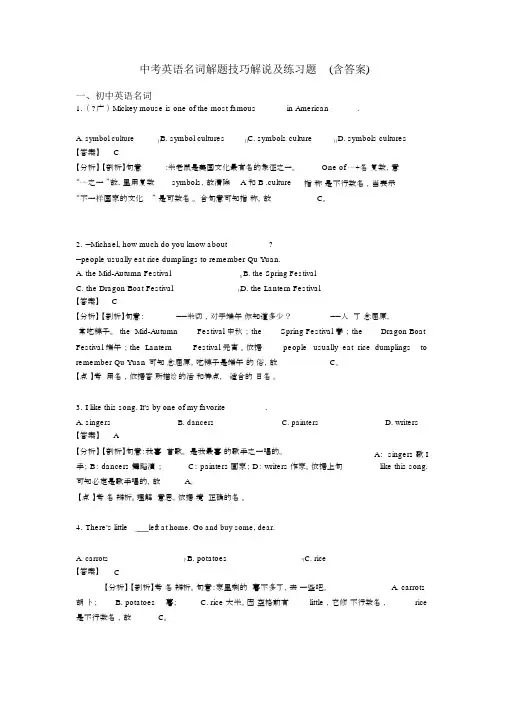
中考英语名词解题技巧解说及练习题(含答案)一、初中英语名词1.( ?广) Mickey mouse is one of the most famous ______ in American ______.A. symbol cultureB. symbol culturesC. symbols cultureD. symbols cultures 【答案】C【分析】【剖析】句意:米老鼠是美国文化最有名的象征之一。
“⋯⋯之一”故. 里用复数symbols,故清除 A 和 B .culture “不一样国家的文化” 是可数名。
合句意可知指称,故One of ⋯⋯+名复数,意指称是不行数名,当表示C。
2.—Michael, how much do you know about _________?—people usually eat rice dumplings to remember Qu Yuan.A. the Mid-Autumn FestivalB. the Spring FestivalC. the Dragon Boat FestivalD. the Lantern Festival【答案】C【分析】【剖析】句意:——米切,对于端午你知道多少?——人了念屈原,常吃粽子。
the Mid-Autumn Festival 端午; the LanternFestival 中秋; the Spring Festival 春; the Dragon Boat Festival 元宵。
依据people usually eat rice dumplings toremember Qu Yuan可知念屈原,吃粽子是端午的俗,故C。
【点】考用名,依据答所描绘的活和特点,适合的日名。
3.I like this song. It's by one of my favorite_________.A. singersB. dancersC. paintersD. writers 【答案】A【分析】【剖析】句意:我喜首歌。
八年级英语名词练习题30题答案解析1.There is a beautiful park near my house. “park” is a _____.common noun(普通名词)proper noun(专有名词)答案:common noun。
解析:“park”是普通名词,不是特定的独一无二的名称,而是表示一类事物的名称。
2.New York is a big city. “New York” is a _____.common noun(普通名词)proper noun(专有名词)答案:proper noun。
解析:“New York”是专有名词,是特定的独一无二的地名。
3.I like apples. “apples” is a _____.common noun(普通名词)proper noun(专有名词)答案:common noun。
解析:“apples”是普通名词,表示一类水果的名称。
4.The Great Wall is very famous. “The Great Wall” is a _____.common noun(普通名词)proper noun(专有名词)答案:proper noun。
解析:“The Great Wall”是专有名词,是特定的独一无二的名胜古迹名称。
5.I have a pen. “pen” is a _____.common noun(普通名词)proper noun(专有名词)答案:common noun。
解析:“pen”是普通名词,表示一类文具的名称。
6.London is the capital of the UK. “London” is a _____.common noun(普通名词)proper noun(专有名词)答案:proper noun。
解析:“London”是专有名词,是特定的独一无二的城市名称。
7.I read books every day. “books” is a _____.common noun(普通名词)proper noun(专有名词)答案:common noun。
名词专题剖析与专题同步训练(含答案)一、初中英语名词1.——_____foggy day !——Something must be done to solve the haze problem .A. HowB. WhatC. What a【答案】 C【解析】【分析】感叹句主要有what和how构成:1、what修饰名词或名词短语,有以下两种形式:1. What+a(an)+(形容词)+单数可数名词+主语+谓语!或是:What+名词词组+主语+谓语!2. What+(形容词)+可数名词复数或不可数名词+主语+谓语!2、How引导的感叹句。
how用来修饰形容词、副词或动词。
其结构是:How+形容词(副词)+主语+谓语!根据下文foggy day,选C。
【点评】考查感叹句2.(•徐州)I love __________. I hope one day I can take part in one of them, answer all the questions and win a big prize!A. chat showsB. game showsC. cartoonsD. documentaries【答案】 B【解析】【分析】句意:我喜欢游戏节目。
我希望有一天我可以参加其中的一个,回答所有的问题,赢得大奖!chat shows访谈节目;game shows游戏节目;cartoons卡通片;documentaries纪录片;根据answer all the questions and win a big prize!可知回答问题,应大奖的节目应是游戏节目。
故选B。
【点评】此题考查名词的辨析。
根据句意可选出答案。
3.(·柳州)Paul is a friend of .A. my brotherB. my brothersC. my brother's【答案】 C【解析】【分析】句意:保罗是我弟弟的一个朋友。
中考英语名词词义辨析练习40题含答案解析1.My father is a doctor. He works in a big hospital. His job is to take care of sick people. People come to him for help when they are not feeling well. He is very kind and patient. What's his job?A.teacherB.doctorC.policemanD.worker答案解析:B。
A 选项“teacher”表示老师,是在学校里教书的人;B 选项“doctor”是医生,题干中明确提到父亲在医院工作,照顾病人,所以是医生;C 选项“policeman”是警察,负责维护治安等工作;D 选项“worker”是工人,通常在工厂等地方工作。
2.Mary wants to be a singer when she grows up. She loves singing and has a beautiful voice. What does she want to be?A.actorB.singerC.writerD.painter答案解析:B。
A 选项“actor”是演员,主要通过表演来展现角色;B 选项“singer”是歌手,喜欢唱歌且有好嗓音的Mary 想成为歌手;C 选项“writer”是作家,通过写作创作作品;D 选项“painter”是画家,用画笔创作。
3.Tom's mother is a teacher. She teaches students in a school. She is very responsible and loves her students. What's her job?A.nurseB.teacherC.engineerD.cook答案解析:B。
人教版高考英语名词深度理解练习题20题含答案解析1.There is a lot of ______ in this area.A.pollutionB.pollutionsC.polluteD.pollutes答案解析:A。
pollution 是不可数名词,B 选项是错误的,因为不可数名词没有复数形式。
C 和D 选项都是动词形式,不符合题意。
所以选A。
2.She has a great collection of ______.A.stampB.stampsC.stampesD.stamped答案解析:B。
stamp 是可数名词,有复数形式stamps。
A 选项是单数形式,不能和a great collection of 搭配。
C 和D 选项都是错误的形式。
所以选B。
3.There is little ______ in the fridge.kkskykes答案解析:A。
milk 是不可数名词,没有复数形式。
B 选项错误。
C 选项是形容词,不符合题意。
D 选项错误。
所以选A。
4.He bought some ______ yesterday.A.booksB.bookesC.bookD.bookies答案解析:A。
book 是可数名词,some 后面接可数名词复数形式books。
B 和D 选项是错误的形式。
C 选项是单数形式,不符合题意。
所以选A。
5.There is much ______ in the river.A.waterB.watersC.wateryD.watered答案解析:A。
water 是不可数名词,没有复数形式。
B 选项错误。
C 选项是形容词,不符合题意。
D 选项是动词的过去分词形式,不符合题意。
所以选A。
6.She has a few ______ of flowers.A.bouquetsB.bouquetC.bouqueting答案解析:A。
bouquet 是可数名词,a few 后面接可数名词复数形式bouquets。
中考英语名词词义辨析练习题40题1<背景文章>In our school life, there are many different activities that we can take part in. We have various classes like English, math, science and so on. In English class, we learn new words and grammar rules. The teacher often uses interesting methods to make the class lively.We also have different clubs. There are art clubs, music clubs, sports clubs and more. If you are interested in painting, you can join the art club. In the art club, you can learn different painting techniques and create beautiful works of art.Sports competitions are also an important part of school life. We have basketball games, football matches and track and field events. During these competitions, students show their skills and teamwork.1. In English class, we learn new ___ and grammar rules.A. booksB. wordsC. pensD. desks答案:B。
名词专项讲解与训练(练习、答案解析)1. I'm so hungry and thristy. Please give me ___________ .bread and a cup of milk breads and a cup of milkpiece of bread and a cup of milk piece of bread and a cup of milk.考查的知识点:本题考查的是不可数名词的修饰词。
疑难点:掌握初中阶段常见不可数名词是解题的关键所在,同时要求学生掌握“数词+容器+of+不可数名词"的结构,并懂得在数词大于一时,将容器名词变为复数形式。
解析:题U中的bread和milk均是不可数名词,C选项中运用了正确的修饰词; 选项中A和B中将bread错认为可数名词,所以不选;选项D中修饰词使用正确,但容器名词没有因应语境要求变为复数,故不选。
答案:本题正确答案为C。
2. How many are there on the table考査的知识点:本题考查的是可数名词的复数变化规律。
疑难点:可数名词规则变化中提到以。
结尾的可数名词一般要加・es变为复数形式:但同时也提到,有一部分以0结尾的的单词并不遵循这一规律,如photo, piano等,学生容易忘记这一点,从而导致错误的发生。
解析:由题干信息many和are可知,所选项应为可数名词复数形式,故首先可排除C选项;其次,根据可数名词规则变化中提及到的部分以0结尾的名词,如photo,直接在词尾加-S变为复数形式,故选B。
类似的只在词尾加-S的以O结尾的可数名词还有radio、piano、zoo等。
答案:本题正确答案为A。
3.1want some _________ for dinner.A. fish C. fishs考查的知识点:本题考査的是可数名词不规则变化的单复数同型的知识点。
疑难点:fish这个单词的比较特别。
专题2 名词知识组一名词的数一可数名词的数Point 1 可数名词复数形式的规则变化1.一般情况下,直接在名词词尾加-s.2.以-s,-x,-ch,-sh结尾的名词直接在词尾加-es.注意:stomach的复数形式为stomachs,因为词尾的ch发/k/.3.以-f或-fe结尾的名词,把f或fe变为v,再加-es.4.以“辅音字母+y”结尾,变y为i,再加-es.5.以“元音字母+y”结尾,直接加-s.6.以“辅音字母+o”结尾,多数情况下加-es.7.以“辅音字母+o”结尾,一般加-s.Point 2 可数名词复数形式的不规则变化8.改变单词内的元音字母:如foot-feet,tooth-teeth,mouse-mice,man-men,policewoman-policemen9.词尾加-en或-ren.ox-oxen,child-children10.有些名词单复数同形。
如,sheep,deer,means,series,works11.表示某国人的名词,有三种情况:(a)单复数相同;如Japanese,Chinese,Swiss (b)变-man为-men;Frenchman-Frenchmen,Englishman-Englishmen(c)词尾加-s,German-Germans,Russian-Russians,American-Americans.请按照单数名词变复数规则,变换下列单数名词。
desk________________ glass________________box________________ brush________________leaf________________ thief________________wife________________ wolf________________factory________________ goose________________monkey________________ mouse________________month________________ foot________________bath________________ hero________________brush________________ German________________dog________________ Negro________________friend________________ photo________________map________________ Chinese________________watch________________ Swiss________________Point 3 复合名词的复数形式:1.一般将主体名词变为复数。
father-in-law →fathers-in-law, passer-by→passers-by,looker-on→lookers-on, editor-in-chief →editors-in-chief2.无主体名词的在词尾加复数。
如:grown-ups, good-for-nothings(无用的人),go-betweens (中间人),look-outs(守望者)3.由man, woman,构成的复合名词应将-man(-woman)变成复数形式-men(或-women);但若是由man(或woman)作前置定语,则常把定语和被修饰语都变成复数,即“men或women+复数名词”。
例如:fireman-firemen, firewoman-firewomenMan doctor-men doctors, woman teacher-women teachersPoint 4 集体名词的数(1)有些集体名词以单数形式出现,但表示复数意义;作主语时,谓语动词用复数形式。
例如:People,police,cattleThe police are looking for him.(2)表示一个国家的国民总称的名词通常用作复数。
The Chinese are hard-working and brave.(3)有些集体名词视为不可数名词;作主语时,谓语动词用单数。
这类名词有:Clothing,furniture,luggage,jewelry,poetry,equipment,mankind,machinery,scenery...The old machinery is out of date.(4)有些集体名词既可以表示单数意义,又可以表示复数意义。
若把集体名词看作一个整体,表示单数意义,作主语时谓语动词用单数形式;若强调集体中的各个成员,表示复数意义,作主语时谓语动词用复数形式。
这类名词常见的有:family,couple,class,team,group,board,government,crowd,committee,audience,party(政党), jury(陪审团),youth(青少年),public公众All my family enjoy skiing.二不可数名词的数不可数名词所表示的事物一般不能用数来计算,没有词形变化,不能和a/an 连用。
Point 1 不可数名词的数量表达(1)不可数名词可用much,some,(a) little, a lot of,no,any等修饰。
much water 许多水some coffee 一些咖啡 a little juice 一点儿果汁a lot of money 很多钱I didn’t eat nay meat.There’s some milk in the glass.(2)不可数名词的数量可用适当的量词来表示,结构为“数词或冠词+量词+of+不可数名词”,量词可以是单数也可以是复数,但of后的名词只用单数形式。
A burst of laughter 一阵笑声four items of news 四条消息Two pieces of advice 两条建议Point 2 不可数名词的转换(1)可转化为可数名词的物质名词当物质名词表示该物质的数量、种类、份数等时,可以转化为可数名词,可用不定冠词修饰或以复数形式来表示。
Coffee-two coffees 两杯咖啡Tea- a tea 一杯茶Rain -a rain 一场雨Snow-a snow 一场雪Fish-fishes 多种鱼Food-foods 多种食物First, I heard a noise. 我先是听到一阵噪音。
(表数量)The potato is a vegetable, not a fruit. 土豆是一种蔬菜,不是水果。
(表种类)Two strong black coffees,please.请来两杯不加奶的咖啡。
(表份数)(2)可转化为可数名词的抽象名词抽象名词表示具体的事物时,可用作可数名词,被不定冠词a/an修饰,表示“某个人或物”。
A success 一个成功的人或一件成功的事A failure 一个失败的人或一件失败的事A surprise 一件令人惊讶地事A pleasure 一件令人高兴的事A pity 一个令人遗憾的事A wonder 一个神奇的人或一件神奇的事三名词单复数的特殊用法Point 1 总以复数形式出现的用法表示由两个或多个部分组成一个整体的事物的名词一般总以复数形式出现,这类名词前不能用不定冠词,也不能用具体的数词修饰,但可以用a pair of,many等修饰。
Glasses,trousers, gloves, shoes,scissors(剪刀),socks,jeans,Point 2 复数形式表示特殊意义的名词Good好处- goods商品,货品water水-waters水域,海域Paper 纸-papers 文件,公文work-works 作品;工厂Arm胳膊-arms武器custom习俗-customs海关Manner方式,态度-manners 礼貌,礼仪Wood木材-woods树林四名词的数量修饰词1.只能修饰可数名词的词Both, few, a few, these, those, many, a good many,a (large) number of, a score of, scores of, a dozen of, dozens of,......2.只能修饰不可数名词的词Little, a little, much, too much, a bit of, a (great) deal of, a large amount of, quite a little,......3.既可修饰可数名词又可修饰不可数名词的词Any, all, half, most,some, plenty of, masses of,a lot of, lots of, a (large) quantity of, quantities of......练习( ) 1. These ______ have saved many children's lives.A.woman doctorsB. women doctorC. women doctorsD. woman doctor ( ) 2. There are many ________ on the mountain.A.apple treeB. apples treesC. apples treeD. apple trees ( ) 3. This is _______bedroom. The twin sisters like it very much.A.Anna and JaneB. Anna's and Jane'sC. Anna's and JaneD. Anna and Jane's( ) 4. ---Are there any _______ on the farm?---Yes, there are some.A.horseB. duckC. chickenD. sheep( ) 5. ---What would you like to drink, _______ or orange?---Orange, please.A.hamburgerB. chipC. teaD. cakes( ) 6. --- They are thirsty. Will you please give them ______ ?--- Certainly.A.some bottles of watersB. some bottles of waterB.C. some bottle of water D. some bottle of waters( ) 7. Mike hurt one of his ______in the accident yesterday.A.toothB. feetC. handD. ear( )8. There is some _______ on the plate.A.cakesB. meatC. potatoD. pears( )9. There are many _______ in the city.A.GermenB. GermanyC. GermanysD. Germans ( )10. The______ has two _______ .A.boys; watchesB. boy; watchC. boy; watchesD. boys; watch( )11. The little baby has two _______ already.A.toothB. toothsC. teethD. teeths( )12. ---It's dangerous here. We'd better go out quickly.---But I think we should let ______go out first.A.woman and childrenB. women and childC. woman and childD. women and children( )13. Are they going to have a party on _______ ?A.Children's DayB. Childrens's DayC. Childrens DayD. Children Day( )14. His father went to his doctor for _______about his trouble.A .an advice B.some advice C advices D .the advices ( )15. Swimming is ______in summer.A .a great fun B.great fun C .great funs D .great a fun ( )16. Is there ______on that plate?A.some chickenB.any chickenC.some chickens Dany chickens知识组2 名词的所有格(一)有生命名词的所有格1.单数名词在词尾加“-’s”my sister’s pen the doctor’s degree Mr. Smith’s car2.以s或es结尾的名词或复数,只在词尾加’.the teachers’ office, the workers’ club4.不是以-s结尾的复数名词的所有格,直接在词尾加“’s”.Women’s clothing, children’s readings5.复合名词的所有格直接在词尾加“’s”her daughter-in-law’s house , one and a half hours’ ride6.并列名词表示共同所属时,只在最后一个名词后加“’s”;如果表示各自所属,则分别在每个名词后加“’s”。